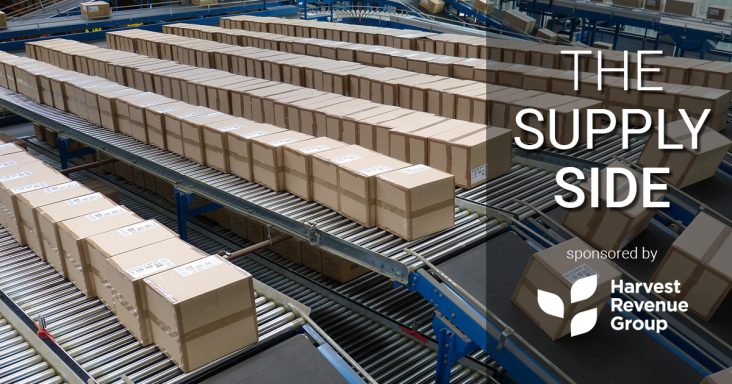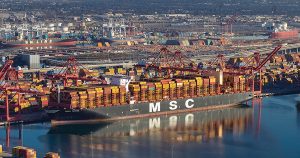The Supply Side: Retailers expect higher costs from proposed import tariffs
by January 9, 2025 9:56 am 657 views

The National Retail Federation (NRF) and Hackett Associates report retailers are under pressure as they front load cargo to avoid the disruption of a possible strike and higher costs from tariffs that President-elect Donald Trump has vowed to increase once he takes office on Jan. 20.
“We hope that both can be avoided, but bringing in cargo early is a prudent step to mitigate the impact on our industry, consumers and the nation’s economy,” said Jonathan Gold, NRF vice president of supply chain and customs. “We call on both parties at the ports to return to the table, get a deal done and avoid a strike. And we call on the incoming administration to use tariffs in a strategic manner rather than a broad-based approach impacting everyday consumer goods.” (A port strike was averted when a tentative agreement was announced Jan. 9.)
Ben Hackett of Hackett Associates said it’s not clear whether the Trump tariffs would take place immediately or require more time to implement.
“Shippers are moving up as much cargo as they can before Jan. 20,” Hackett added.
U.S. ports handled 2.25 million containers in October, although the Port of Miami has yet to report final data. That was down 1.2% from September but up 9.3% compared with September 2023. Ports have not yet reported November’s numbers, but Global Port Tracker projected the month at 2.17 million containers, up 14.4% year-over-year.
 December is forecast at 2.14 million containers, up 14.3% year-over-year. That would bring 2024 to 25.6 million containers, up 14.8% from 2023. The new forecast is higher given the looming threats. Hackett forecasts 2.2 million containers for January, up 12% from the prior year.
December is forecast at 2.14 million containers, up 14.3% year-over-year. That would bring 2024 to 25.6 million containers, up 14.8% from 2023. The new forecast is higher given the looming threats. Hackett forecasts 2.2 million containers for January, up 12% from the prior year.
Container xChange found the North American region saw the largest increase in average container prices, with 40-foot high-cube cargo-worthy container prices rising by 20% over the past 90 days. North America was the most volatile market followed by East Africa and Southeast Asia.
Average container prices at the port of Long Beach in California rose from $2,594 in October to $3,400 in November, a 31% increase, which indicates a tighter market for U.S. container trading. The higher costs add pressure to retailers who find it difficult to raise prices amid sustained inflation that ticked higher in November.
Statista reports the container freight rate index, which measures container costs in U.S. dollars, peaked July 11 at $5,901 per 40-foot container. Since then rates decreased to $3,095 per container in late October, only to spike again following the Nov. 5 election. Container rates stood at $3,295 on Dec. 12, according to the Drewry World Index.
A Dec. 6 report from eMarketer pegs proposed tariffs of 10% on all imports and an additional 60% on imports from China will lead to 36.3% higher consumer prices on toys and $8.8 billion in lost consumer spending power.
Household appliances could see prices rise 19.4% costing consumers $6.4 billion in spending power. Footwear is also expected to see prices rise 18.1% resulting in $6.3 billion in lost spending power. Apparel could see prices rise 12.5%, which would cost consumers $13.9 billion in spending power. Furniture is another category expected to be impacted with 6.4% higher costs, resulting in $8.5 billion in lost spending power.
RETAILER REACTION TO TARIFFS
Walmart Chief Financial Officer John David Rainey has said new tariffs could force the retailer to raise prices. He said there will probably be cases where prices rise for consumers if tariffs are enacted. He stopped short of saying which products are most in jeopardy from tariffs. He said two-thirds of what Walmart sells is made or grown in the U.S., but even before the pandemic and the related supply chain disruptions, the company has tried to import from different parts of the world, reducing its reliance on China.
“We’ve been living under a tariff environment for seven years, so we’re pretty familiar with that,” he said. “Tariffs, though, are inflationary for customers, so we want to work with suppliers and with our private brand assortment to try to bring down prices.”
Footwear manufacturer Steve Madden announced plans to reduce the goods it imports from China by as much as 45% over the next year in light of the volatile geo-political climate and tariff threats. Lowe’s CEO Marvin Ellison recently told investors he was concerned about the risks of higher costs. He said he is having conversations with suppliers about possible tariffs.
“We’re not waiting to act,” he said. “We’ve got plans in place. We’ve got scenarios in place, and we’re trying to understand the implications.”
Roughly 40% of Lowe’s cost of goods sold comes from outside of the U.S., including direct imports and merchandise from national brands. In a recent earnings call, Lowe’s execs said tariffs would certainly add to product costs although the timing and details remain uncertain.
Target is seen as more vulnerable to proposed tariffs than Walmart given that 60% of the Bentonville behemoth’s sales come from grocery. Target relies more heavily on apparel, beauty and houseware sales, which constitute 75% of the company’s revenue.
“We’re concerned about tariffs because they lead to higher prices on everyday products for American families,” Target CEO Brian Cornell said in November.
He said the proposed Trump tariffs amounted to $50 million to $60 million in added costs per quarter. Oliver Chin, an analyst with TD Cowen, said apparel is sensitive to seasonality, making it more difficult to pull orders ahead of the tariffs or to line up new suppliers in time for the season.
The share of corporate chief financial officers citing “tariffs” as their company’s most pressing concern shot up 173% after the election compared to the period prior to the election, according to CFO Survey which is conducted by Duke University and the Federal Reserve Banks of Richmond and Atlanta.
Best Buy is vulnerable to tariffs because the majority of consumer electronics products are imported. The company said it will order ahead and bring in additional products before tariffs hit while also adjusting its supplier mix and item inventory.
Dollar Tree is also vulnerable, but the discounter said it is making adjustments, negotiating lower supplier costs, resizing packages, and dropping items that no longer make financial sense. The company also expects to shift suppliers for most products to alternate countries and hike prices on some goods.
Editor’s note: The Supply Side section of Talk Business & Politics focuses on the companies, organizations, issues and individuals engaged in providing products and services to retailers. The Supply Side is managed by Talk Business & Politics, and is sponsored by Harvest Revenue Group.
